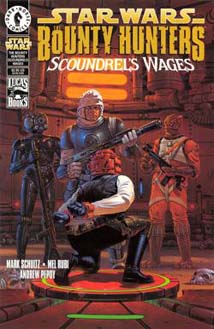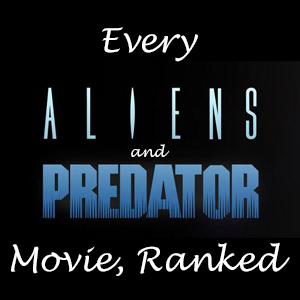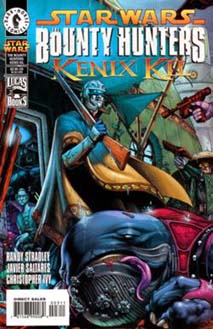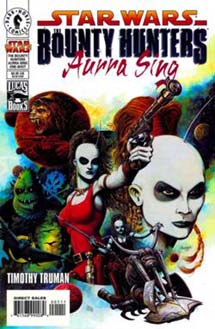In the midst of re-reading the “Star Wars: Republic” ongoing series, I decided to peek ahead on the timeline in search of more information about Aurra Sing in “The Bounty Hunters: Aurra Sing.” And for the sake of keeping things together, that means re-reading “The Bounty Hunters” three-issue series (1999), which also includes “Scoundrel’s Wages” and “Kenix Kil.”
Written by foremost Aurra Sing scribe Tim Truman, the “Aurra Sing” entry doesn’t provide any new information on the “Episode I” era’s most famous bounty hunter, but it is a ripping good yarn that features sharp artwork by Truman and intriguingly moody coloring by Dave McCaig, who usually prefers more vibrant colors.
I have mixed feelings about Truman’s decision to have Aurra track three beings (two of whom are decoy shapeshifters and one of whom is her actual target) to Hoth, Tatooine, Bespin and Endor, which represent liquid, flame, sky and land, respectively. It’s ridiculous that in a Republic that has 100,000 worlds (according to the “Phantom Menace” novelization) – to say nothing of the worlds outside the Republic – that Aurra’s hunt just happens to take her to four worlds of Luke Skywalker’s hero’s journey.
On the other hand, Truman is one of the elite continuity writers from the Dark Horse “Star Wars” run. He gives a nod to Hoth’s lumni lichen (from the Goodwin/Williamson strips), Wuher the bartender, the thranta riders of Bespin (from the “Young Jedi Knights” books) and Ewoks. I had to smile at seeing Ewoks in a violent “Bounty Hunters” comic.

“Scoundrel’s Wages,” by Mark Schultz, falls halfway between the dark humor of the “Jabba the Hutt” and “Boba Fett” comics and the lighter humor of Jo Duffy’s Lando comics from the post-“Empire Strikes Back” Marvel series. It’s easily the best Lando story put out by Dark Horse (which generally snubbed him), and ultimately it answers a question we didn’t know we were asking: How did Lando get a job as a skiff guard in Jabba’s palace?
Perhaps more importantly, it once again raises the question (most famously posed in the “Family Guy” “Empire” parody) of “Why is Lando wearing Han’s clothes?” Here, it’s partly for the sake of a trick cover image: We assume it’s Han – whose back is to the viewer – being held by 4-LOM, Dengar and Bossk. I’ve always felt the answer to the clothes conundrum was obvious (and intended by the filmmakers): At the end of “Empire,” as Chewie and Lando embark on their search for Han, Lando wears what is available. They were in the middle of a war, Lando escaped from Bespin with the clothes on his back, and those were in the wash. So he dipped into Han’s wardrobe since they happened to be the same size. It makes logical, practical sense.

In Duffy’s Marvel issues, Lando wears his Bespin duds (presumably the laundry had been done back at Rebel HQ). In “Scoundrel’s Wages,” he’s wearing Han’s garb again. What we often forget in an affluent, fashion-conscious culture like modern America is that in eras and regions of poverty and warfare, people’s dress tends to be utilitarian. Luke, Han, Lando and even Leia tended to have a narrow wardrobe of practical outfits throughout the time of the original trilogy (with the exception of dressy occasions like the medal ceremony or the Cloud City dinner), which makes sense for a Rebellion always hiding or on the run. It’s no coincidence that Queen Amidala’s various outfits – in a more (albeit tenuously) peaceful time – contrast this so sharply.

Randy Stradley’s “Kenix Kil” takes place more or less between “Crimson Empire” I and II and tells the story of rogue Emperor’s Royal Guard Kir Kanos adopting the persona of bounty hunter Kenix Kil as part of his grand scheme to kill the enemies of his beloved dead Emperor Palpatine. It shows that Kil acquires his X-wing from a trader rather than via the New Republic, as I had previously thought. It’s amusing to see Kil put out a bounty on Kir Kanos and then kill every member of a powerful bounty hunter cartel at the end of the faux hunt, thus opening up the bounty-hunting market for himself: “Seems a number of positions have suddenly become available. And Kenix Kil now has a verifiable reputation for success.”
However, this sounds a bit fishy, as Kil (obviously) did not succeed in capturing Kir Kanos, he merely succeeded in killing a bunch of bounty hunters. While this may gain him some respect and some clients, it also would seem to hurt him in other circles because he doesn’t follow the bounty hunters’ code (thou shalt not kill other bounty hunters). Probably he can get away with it because he’s so darn good at his job (like Aurra Sing and Boba Fett, who likewise aren’t members of the Bounty Hunters’ Guild, although they tend to be more hesitant than Kenix Kil to murder fellow hunters), but I have to question whether this was the best way to build a name for himself as a bounty hunter.
Overall, these are three classic bounty hunter yarns, two of which tie in with other series and one of which throws Lando fans a bone. My only complaint about “The Bounty Hunters” is that it could’ve been a longer series. While Boba Fett certainly got his due from Dark Horse, it would’ve been fun to see standalone issues featuring each of the other five bounty hunters from the Executor bridge, and perhaps other famous hunters such as Greedo.

